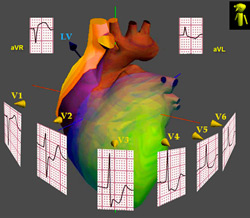Although all of the other activities listed under “What We Do” in some way support diagnosis and therapy, researchers in these other areas are often exploring the theoretical potential of data and technology.
The engineers who focus specifically on diagnostic and therapeutic systems address the practical aspects of research. Rather than exploring the features of cardiac arrhythmias, for example, they consider what, specifically, could be developed to detect such arrhythmias. They look at what is needed in medicine and then help to figure out how to apply the findings of researchers into a functionally-sound product that observes international standards and can overcome regulatory hurdles and existing market forces to ultimately find a place in the healthcare setting. It requires a different mindset and a different skill set.
At the Medical University of South Carolina in Charleston, for example, researchers are working on an image guided, localized therapy to treat cancerous tumors. Interventional radiologists are already using image-guided catheters to inject chemotherapy directly into the blood vessels that feed a tumor, reducing the need for systemic chemotherapy. Tumor tissue can also be thermally ablated, either non-invasively using high intensity ultrasound or using catheters to deliver microwave heat or heat from RF currents. In Charleston, researchers are using patient image data sets and overlaying computer simulations to develop individualized, heat-based treatment plans to destroy tumors while limiting damage to healthy tissue.
Engineers at Philips are working on clinical decision support systems that help physicians to make use of all the data that is routinely captured as patients are being monitored round-the-clock. Less than 1% of these values are actually seen as physicians make their rounds. Such support systems could collect information from various devices, read it, analyze it and then either predict or determine whether a problem is eminent and alert hospital staff. They could also provide physicians with a meaningful analysis to review so they can implement the appropriate therapies. (See also Biomedical Signal Processing)
Where other EMBS activities answer the question, “How does it work?” those in diagnostic and therapeutic systems focus on “How can it be used?” It is incumbent upon engineers to understand the “how” and to properly educate physicians. End-user medical personnel do not, after all, need to understand how a piece of equipment works as long as they know, for example, that they can use microwave energy to perform cardiac ablations.
The Silicon Valley company, NewCardio, has developed a new, 3D approach to electrocardiography (ECG) to enhance the diagnostic value of the traditional ECG. The 3D approach provides faster, more accurate and less expensive assessment of cardiac status—all while using the standard 12-lead ECG. Their QTinno® solution automatically detects cardiac toxicity during new drug development. CardioBip™ is a wireless monitoring solution for remote diagnosis. And my3KG™ allows for timely diagnosis of suspected heart attacks in urgent care settings.
 A typical my3KG™ output that is easy to read and thus requires less training
A typical my3KG™ output that is easy to read and thus requires less training
to interpret, when compared with the standard 12-lead display.
Diagnostic and therapeutic devices or methods are often developed together, even if they are applied by different specialists. After all, there is no need to detect a condition that cannot be treated or to develop a treatment for a condition that cannot be detected.
This is an area where interaction with members of the medical community is especially critical. Engineers cannot develop truly useful devices without working closely with physicians and medical scientists who are immersed in a medical environment. These EMBS members help us to identify needs and narrow the target of research efforts to bring to market products with advanced diagnostic and therapeutic capabilities. Join us
Click here for a list of links to therapeutic systems and technologies currently being developed or now on the market.